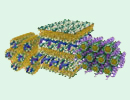


| (See also our Research Highlights & Selected Papers!) | ||
There are several main research areas in the Safinya group, each comprising a number of sub-projects. We study biological systems (e.g. cytoskeletal proteins derived from nerve cells), systems of medical relevance (e.g. complexes of cationic lipids with nucleic acids) as well as synthetic model systems in bulk and under confinement (e.g. in microchannels). A common theme is the quest for a fundamental understanding of the mechanisms underlying lipid, lipid-nucleic acid, and protein-based assembly. Such understanding will lead to the development of nanometer-scale materials with distinct properties important both from a scientific and technological perspective. For example, nanometer-scale tubules and their assemblies are of interest as miniaturized materials with applications as circuitry components, enzyme encapsulation systems, biosensors, and vehicles for chemical delivery. In addition to the biophysical, biochemical, and biomedical aspects of the projects, concepts from liquid crystal and soft condensed matter science are essential to the understanding of the systems studied [1,2]. Our highly interdisciplinary projects rely on a broad spectrum of skills contributed by the group’s members. These range from chemical synthesis (e.g. of custom lipids, peptide-lipids, and PEG-lipids) to biological assays and purification techniques to a range of structure characterization methods such as synchrotron X-ray scattering and diffraction and electron microscopy as well as optical microscopy techniques. The broad variety of structure characterization techniques allows us to probe length scales from sub-nanometer to micrometer. A main strategy of our group is learning from, and building upon, the many illuminating examples of (out-of-equilibrium) assembly occurring in vivo. For example, the cytoskeleton of nerve cells exhibits a rich and complex variety of partially ordered bundles and networks of interacting neurofilaments, microtubules (MTs), and filamentous actin. The nature of these assembled protein structures, the interactions leading to them, and the correlations of structure and biological function remain poorly understood. We are studying nanoscale assembly in model systems composed of reconstituted neurofilament (NF, purified from bovine spinal chord) and MT/MT-associated-protein (MAP) bundles and networks. The long-range goals of this work are to identify parameters which control the forces leading to stable NF/MT networks and bundles, clarify their roles and those of key proteins, and elucidate the biological functions of the hierarchical structures in neuronal processes (axons and dendrites) in health and neurodegenerative diseases. Another main project in the group is centered on the study of structures, properties and delivery efficiencies of lipid–DNA and lipid–siRNA (short-interfering RNA) complexes. The long-range goals of this project are to develop optimal lipid carriers of nucleic acids for gene delivery and gene silencing. Our main interest is to achieve these goals by understanding the basic mechanisms and parameters which govern the efficiencies of lipid–nucleic acid complexes. Our group is affiliated with the Departments of Physics, Materials, Biomolecular Science and Engineering (BMSE) and Molecular, Cellular, and Developmental Biology (MCDB) at the University of California, Santa Barbara (UCSB). Funding for our work comes from the DOE, the NIH, and the NSF. In addition to the education of graduate students and postdoc, our lab is also involved in undergraduate education. Detailed information on our past and current work on various systems can be found in the respective sub-sections of this website. For further reading, refer to our list of selected papers or our complete list of publications. For a comprehensive discussion of the subject matters of soft condensed matter physics and liquid crystal science see textbooks by Chaikin and Lubensky [1] and De Gennes and Prost [2].
|
 |
 |
 |
|
References: [1] P. M. Chaikin, T. C. Lubensky: Principles of Condensed Matter Physics; Cambridge University press, Cambridge, 1995. |